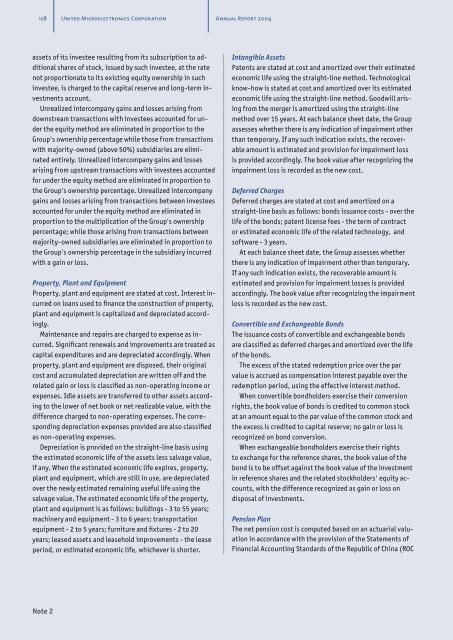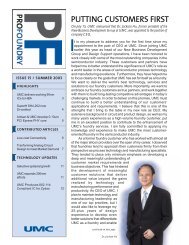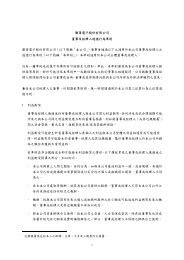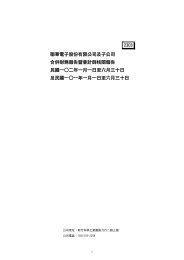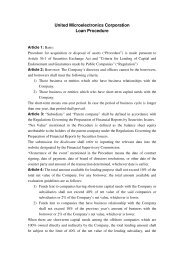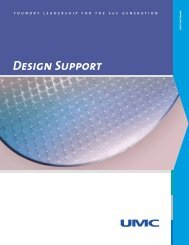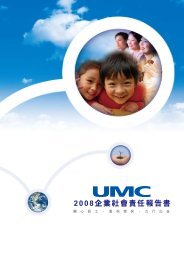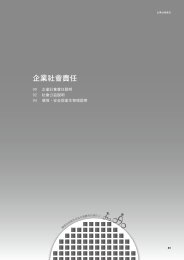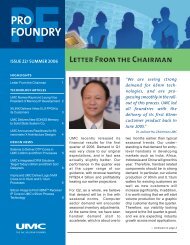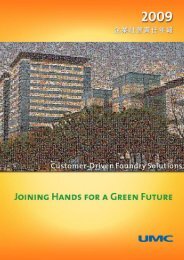Download Full Version - UMC
Download Full Version - UMC
Download Full Version - UMC
Create successful ePaper yourself
Turn your PDF publications into a flip-book with our unique Google optimized e-Paper software.
128 United Microelectronics Corporation Annual Report 2004<br />
assets of its investee resulting from its subscription to additional<br />
shares of stock, issued by such investee, at the rate<br />
not proportionate to its existing equity ownership in such<br />
investee, is charged to the capital reserve and long-term investments<br />
account.<br />
Unrealized intercompany gains and losses arising from<br />
downstream transactions with investees accounted for under<br />
the equity method are eliminated in proportion to the<br />
Group's ownership percentage while those from transactions<br />
with majority-owned (above 50%) subsidiaries are eliminated<br />
entirely. Unrealized intercompany gains and losses<br />
arising from upstream transactions with investees accounted<br />
for under the equity method are eliminated in proportion to<br />
the Group's ownership percentage. Unrealized intercompany<br />
gains and losses arising from transactions between investees<br />
accounted for under the equity method are eliminated in<br />
proportion to the multiplication of the Group's ownership<br />
percentage; while those arising from transactions between<br />
majority-owned subsidiaries are eliminated in proportion to<br />
the Group's ownership percentage in the subsidiary incurred<br />
with a gain or loss.<br />
Property, Plant and Equipment<br />
Property, plant and equipment are stated at cost. Interest incurred<br />
on loans used to finance the construction of property,<br />
plant and equipment is capitalized and depreciated accordingly.<br />
Maintenance and repairs are charged to expense as incurred.<br />
Significant renewals and improvements are treated as<br />
capital expenditures and are depreciated accordingly. When<br />
property, plant and equipment are disposed, their original<br />
cost and accumulated depreciation are written off and the<br />
related gain or loss is classified as non-operating income or<br />
expenses. Idle assets are transferred to other assets according<br />
to the lower of net book or net realizable value, with the<br />
difference charged to non-operating expenses. The corresponding<br />
depreciation expenses provided are also classified<br />
as non-operating expenses.<br />
Depreciation is provided on the straight-line basis using<br />
the estimated economic life of the assets less salvage value,<br />
if any. When the estimated economic life expires, property,<br />
plant and equipment, which are still in use, are depreciated<br />
over the newly estimated remaining useful life using the<br />
salvage value. The estimated economic life of the property,<br />
plant and equipment is as follows: buildings - 3 to 55 years;<br />
machinery and equipment - 3 to 6 years; transportation<br />
equipment - 2 to 5 years; furniture and fixtures - 2 to 20<br />
years; leased assets and leasehold improvements - the lease<br />
period, or estimated economic life, whichever is shorter.<br />
Intangible Assets<br />
Patents are stated at cost and amortized over their estimated<br />
economic life using the straight-line method. Technological<br />
know-how is stated at cost and amortized over its estimated<br />
economic life using the straight-line method. Goodwill arising<br />
from the merger is amortized using the straight-line<br />
method over 15 years. At each balance sheet date, the Group<br />
assesses whether there is any indication of impairment other<br />
than temporary. If any such indication exists, the recoverable<br />
amount is estimated and provision for impairment loss<br />
is provided accordingly. The book value after recognizing the<br />
impairment loss is recorded as the new cost.<br />
Deferred Charges<br />
Deferred charges are stated at cost and amortized on a<br />
straight-line basis as follows: bonds issuance costs - over the<br />
life of the bonds; patent license fees - the term of contract<br />
or estimated economic life of the related technology, and<br />
software - 3 years.<br />
At each balance sheet date, the Group assesses whether<br />
there is any indication of impairment other than temporary.<br />
If any such indication exists, the recoverable amount is<br />
estimated and provision for impairment losses is provided<br />
accordingly. The book value after recognizing the impairment<br />
loss is recorded as the new cost.<br />
Convertible and Exchangeable Bonds<br />
The issuance costs of convertible and exchangeable bonds<br />
are classified as deferred charges and amortized over the life<br />
of the bonds.<br />
The excess of the stated redemption price over the par<br />
value is accrued as compensation interest payable over the<br />
redemption period, using the effective interest method.<br />
When convertible bondholders exercise their conversion<br />
rights, the book value of bonds is credited to common stock<br />
at an amount equal to the par value of the common stock and<br />
the excess is credited to capital reserve; no gain or loss is<br />
recognized on bond conversion.<br />
When exchangeable bondholders exercise their rights<br />
to exchange for the reference shares, the book value of the<br />
bond is to be offset against the book value of the investment<br />
in reference shares and the related stockholders' equity accounts,<br />
with the difference recognized as gain or loss on<br />
disposal of investments.<br />
Pension Plan<br />
The net pension cost is computed based on an actuarial valuation<br />
in accordance with the provision of the Statements of<br />
Financial Accounting Standards of the Republic of China (ROC<br />
Note 2


